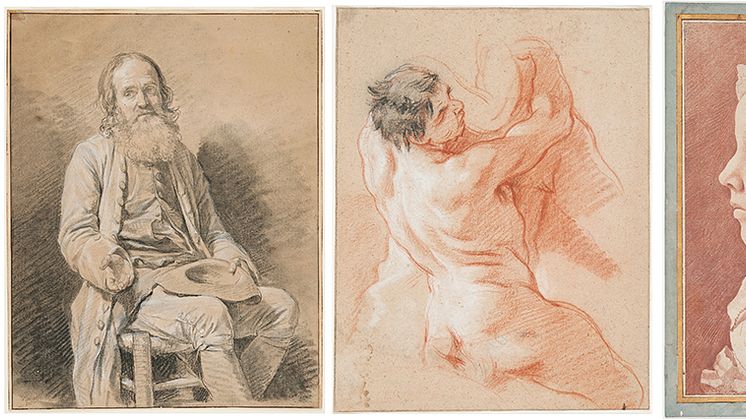
Press release -
New acquisitions: 18th-century French master drawings
Nationalmuseum has acquired three drawings by Edme Bouchardon (1698–1762), François Boucher (1703–70) and Nicolas Bernard Lépicié (1735–84), some of the leading artists of the French 18th century. The works comprise two portraits and a figure study for one of the museum’s most famous paintings, The Triumph of Venus. Each exemplifies how drawing had become a significant art form in its own right in 18th-century France.
The drawing by Edme Bouchardon is a portrait of Geneviève-Thérèse Mariette, the daughter of Bouchardon’s close friend Pierre-Jean Mariette (1694–1774), an engraver and art collector. Mariette had catalogued the collection of the banker Pierre Crozat (1665–1740), sold at auction in Paris in 1741, from which Carl-Gustaf Tessin acquired a number of master drawings now owned by Nationalmuseum. On the back of the drawing, Mariette has noted that this is a portrait of his daughter drawn by Edme Bouchardon in 1736. The following year the artist exhibited six drawings at the Paris Salon, two of them depicting Mariette’s children. The exhibition catalogue describes the piece acquired by Nationalmuseum as “little girl in a bonnet”. The portrait, an exquisite example of Bouchardon’s mastery of the art and techniques of drawing, is a fully fledged work of art. The model is seen in profile, gazing out a little shyly beneath her bonnet. Through sharp outlines and graduated shading in sanguine, Bouchardon has formed blocks that create almost a three-dimensional effect. Works like this, coupled with the fact that the artist exhibited them at the Salon, helped entrench the status of drawing as an art form in its own right.
The recently acquired Boucher drawing is a study for one of the central figures in The Triumph of Venus, regarded by many as the artist’s foremost work. The drawing corresponds to the triton at right in the painting, who is lifting and supporting a naiad. She in turn is holding out a seashell, offering Venus a pearl necklace. As the triton lifts the naiad, he twists his body, and Boucher has captured the action of the muscles in a way that appears free yet exact. The lines of red and black chalk are drawn with a strong, confident hand. The sensual touch typical of the artist and so readily apparent in the painting is perhaps even more pronounced in this study. Boucher has not yet clothed the naked naiad, and the triton’s lift in this work also becomes an ardent embrace. This drawing is the only known preparatory study for The Triumph of Venus.
The last of the three drawings is also a preparatory study but gives the impression of being a fully fledged work. Nicolas Bernard Lépicié studied under Carle van Loo (1705–65) and, as a historical painter, was admitted to the Académie royale de peinture et de sculpture in 1769. He later focused increasingly on genre painting. The Lépicié drawing is a study for the man in the painting Old Beggar with Child, signed and dated 1777 and now in an American private collection. The drawing is a complete work in which the beggar’s doleful expression is as powerful as in the finished painting. Although the drawing started out as a preparatory study, it seems that, as he worked on it, Lépicié became convinced of its merits as a standalone piece. This may be the reason why he signed it.
The three works described above are superb examples of 18th-century French drawing. The Bouchardon and Boucher drawings in particular are significant acquisitions in art history terms: the former with its direct connection to Pierre-Jean Mariette and the emergence of drawing as an art form at the Salon; the latter as the sole surviving preliminary study for The Triumph of Venus, a major work in 18th-century art history.
Nationalmuseum receives no public funding for new acquisitions, but relies on gifting and financial support from private funds and foundations to enhance its collections of fine art and craft. These acquisitions have been made possible by a generous donation from the Hedda and N D Qvist Memorial Fund and the Wiros Fund.
Inventory numbers:
Edme Bouchardon, Portrait of Geneviève-Thérèse Mariette: NMH 64/2017
François Boucher, Study of a triton: NMH 60/2017
Nicolas Bernard Lépicié, Old Beggar: NMH 61/2017
For more information, contact
Daniel Prytz, curator, +46 8 519 543 06, daniel.prytz@nationalmuseum.se
Mattias Robertson, press officer, +46 767 23 46 32, press@nationalmuseum.se
Categories
Nationalmuseum is Sweden’s premier museum of art and design. The collections comprise older paintings, sculpture, drawings and graphic art, and applied art and design up to the present day. The museum building is currently under renovation and scheduled to open again in 2018. In the meantime, the museum will continue its activities through collaborations both in Sweden and abroad as well as temporary exhibitions at Nationalmuseum Design at Kulturhuset Stadsteatern in Stockholm. Nationalmuseum has partnerships with Svenska Dagbladet and the Grand Hôtel Stockholm.

